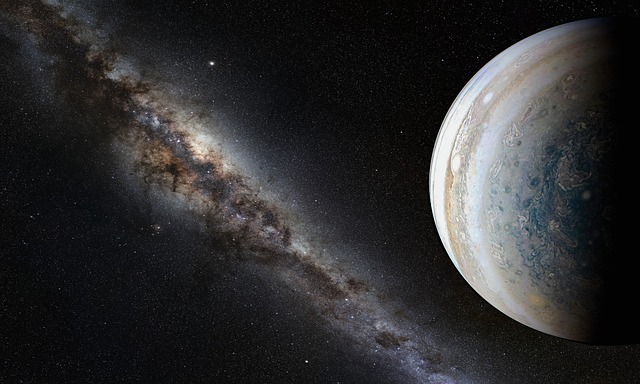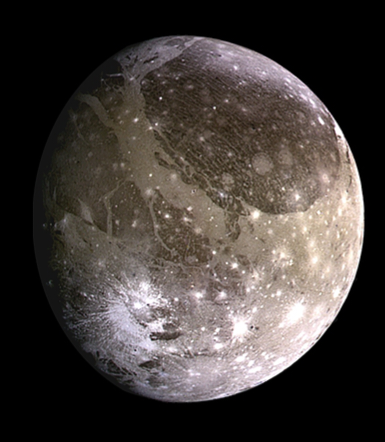*This post may contain affiliate links. This means we may make a commission if you purchase an item using one of our links*
The main differences between Jupiter and Ganymede would be that Jupiter is the largest planet in our solar system, has 79 moons orbiting it, it orbits the Sun whilst also displaying the strongest magnetic field in our local region of space whilst Ganymede is the largest moon in our solar system, has a magnetopshere unlike most other moons and orbits Jupiter.
There are various other differences between the two so, continue reading for a more detailed look at each of these cosmic entities, their similartities and their differneces.
What Is The Planet Jupiter?
Table of Contents

Jupiter is the 5th farthest planet from the Sun and the largest planet within our local solar system. The planets most recognizable trait is the giant red spot visible on its atmosphere along with the brown horizontal bands flowing across its atmosphere.
As a result of its composition and size, Jupiter falls under the classification of a gas giant.
This is because its composition mostly consists of the elements hydrogen and helium. The split is roughly 71% hydrogen, 27% helium, with the remainder of the elements split throughout the left over 2%.
As the biggest planet in our solar system, Jupiter is 139,820 km or 1,300 Earths in diameter, it has a mass of around 0.001 solar masses, the temperature when inside the clouds are roughly -145 degrees Celsius whilst the core is far hotter, equating in the region of 24,000 degrees Celsius.
Due to its extreme circumstances, gaseous composition and distance from the Sun, the planet is not theoretically capable to support life, from its subzero temperature to the extremely fast 640 km/h winds, and its gravity which may be unsustainable for our bones, roughly 2.4 times greater than Earth’s.
Although the conditions on Jupiter aren’t suitable for us, some of its 79 moons like Europa for example could support life.
This brown giant has a relatively fast rotation around its axis where 1 rotation typically takes 10 hours to make whilst its orbit around the Sun is far longer taking in the region of 12 years for 1 full cycle.
Another feature of Jupiter that is renowned by astronomers is the strength of its magnetic field. In comparison to the other planets in our solar system it is even stronger than our Sun, where it’s over magnetosphere is roughly 20,000 times the strength of Earth.
What this means is that Jupiter’s magnetosphere is able to avert solar winds that are 3 million kilometers away from it.
What is The Moon Ganymede?

Ganymede is the largest of the Galilean moons – and the largest moon in our entire solar system – first discovered on 7th January 1610. The surface of this icy world is frozen and covered by two main types of landscape: young, light regions and old, crater-filled terrain. And these darker areas seem to contain a number of organic materials.
Using the Hubble Space Telescope, astronomers have found evidence of an oxygen-based atmosphere. Still, it is far too thin to support any living organisms that we know of. Based on this, it’s unlikely that Ganymede hosts life as we know it.
Estimates place Ganymede at around 4.5 billion years old (the same age as its planet, Jupiter), and its average distance from the Sun is approximately 778 million km.
Its diameter is 5,268km, making it larger than the planet Mercury. Despite this, Ganymede only possesses half the mass of Mercury at 1.48 × 10^23kg, so it is still classified as a low-density object.
Ganymede takes seven days to orbit its planet at an average distance of 665,00km, and the temperature varies from minus 112 to minus 193 degrees Celsius. In regards to the moon’s core temperature, that would be around 1,226 – 1,446 degrees Celsius.
Among the fascinating features of this ice moon is its magnetosphere. While many planets possess a magnetosphere, no other moon in our solar system shares this trait.
Measuring the changes in the magnetic fields of Ganymede and Jupiter allowed scientists to predict that salt water lies beneath the surface of this freezing world.
However, this is insufficient to support life when you factor in the other elements of this giant moon. In contrast to Europa, the rocky layer of Ganymede is not directly below the ocean, so life would have a difficult time forming both above and below the ice.
In addition, the thick layer of ice on the moon’s surface would make internal, water-based life challenging for scientists to detect.
Similarities Between Jupiter And Ganymede
There are a few similarities that Jupiter and Ganymede share, which in this case includes the following:
- Both are a spherical shape.
- Both have a hotter core.
- Both are part of the same solar system.
- Neither have tectonic plates.
- Both orbit another object.
- Both take roughly 12 years to orbit the Sun.
- Both have a magnetosphere.
Differences Between Jupiter And Ganymede
In regards to the differences between the two, they include the following:
- Ganymede is tidally locked to Jupiter whilst Jupiter is not tidally locked to anything.
- Jupiter has 79 moons orbiting it whilst Ganymede has 0.
- Jupiter is a gas gaint composed mostly of hydrogen and helium whilst Ganymede is a terrestrial based entity composed mostly of rocks and a thin to non-existent atmosphere.
- Jupiter has the strongest magnetosphere in the entire solar system, which is significantly more powerful than Ganymede’s.
- Ganymede has a diameter of 5,268km whilst Jupiter’s diameter is 139,820km.
- Jupiter’s average temeprature is around -145 degrees Celsius whilst Ganymede averages between -112 to -193 degrees Celsius.
- In regards to their cores temperature, Jupiter’s is 24,000 degrees Celsius whilst Ganymede’s is 1,226 – 1,426 degrees Celsius.
- Jupiter’s graviational strength is 24.79 m/s² whilst Ganymede’s is 1.428 m/s².
- Ganymede has a density of 1.94 g/cm³ whilst Jupiter’s is 1.33 g/cm³.
- Jupiter’s mass is 1.898 × 10^27 kg whilst Ganymede’s is 1.48 × 10^23kg.
- A day on Jupiter is 10 hours whilst a Ganymede day is 7 days 3 hours.
- Ganymede orbits Jupiter in 7 days and 3 hours.
- Ganymede orbits Jupiter elliptically whilst Jupiter orbits the Sun in an almost circular pattern.
- Jupiter’s axial tilt is 3.13 degrees whilst Ganymede’s axial tilt is between 0 – 0.33 degrees.
Summary
Jupiter and Ganymede have the odd few commonalities such as the fact one orbits the other, that both are the biggest object of their type in the solar, both have a magnetosphere among others features.
However, they are very different from one another too whether it be in regards to their size, mass, composition, the length of their days and more. All in all both are very distinct entities, operating and functioning in a completely unique manner from one another.

